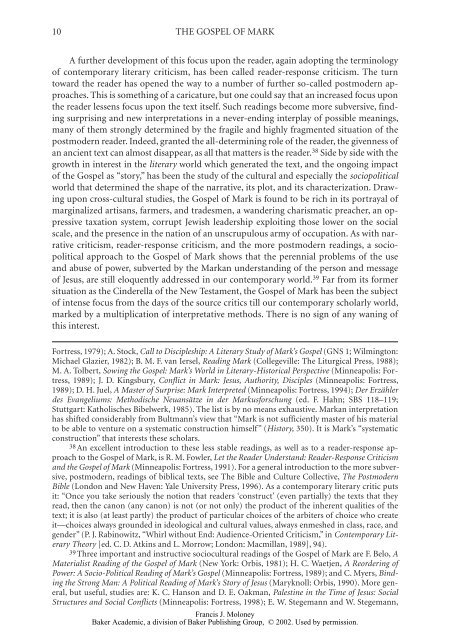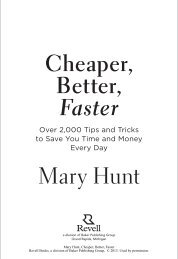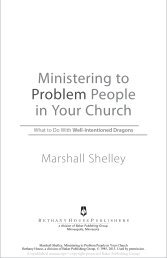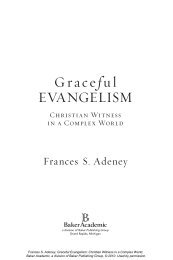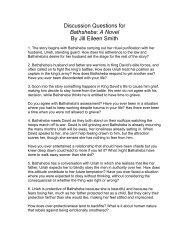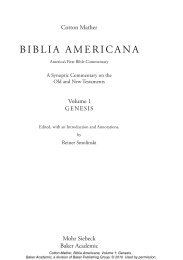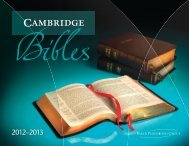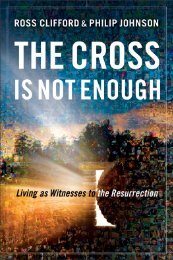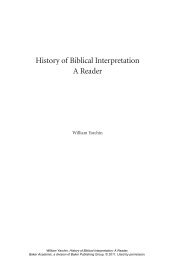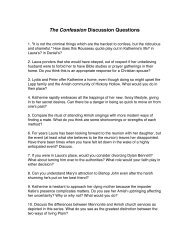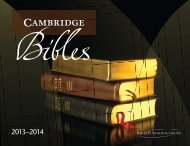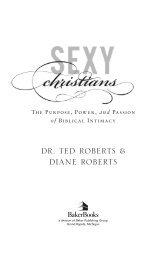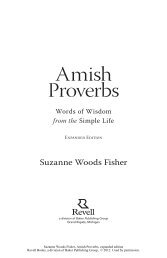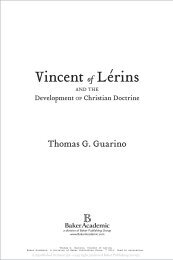the gospel of mark a commentary - Baker Publishing Group
the gospel of mark a commentary - Baker Publishing Group
the gospel of mark a commentary - Baker Publishing Group
Create successful ePaper yourself
Turn your PDF publications into a flip-book with our unique Google optimized e-Paper software.
10 THE GOSPEL OF MARK<br />
A fur<strong>the</strong>r development <strong>of</strong> this focus upon <strong>the</strong> reader, again adopting <strong>the</strong> terminology<br />
<strong>of</strong> contemporary literary criticism, has been called reader-response criticism. The turn<br />
toward <strong>the</strong> reader has opened <strong>the</strong> way to a number <strong>of</strong> fur<strong>the</strong>r so-called postmodern approaches.<br />
This is something <strong>of</strong> a caricature, but one could say that an increased focus upon<br />
<strong>the</strong> reader lessens focus upon <strong>the</strong> text itself. Such readings become more subversive, finding<br />
surprising and new interpretations in a never-ending interplay <strong>of</strong> possible meanings,<br />
many <strong>of</strong> <strong>the</strong>m strongly determined by <strong>the</strong> fragile and highly fragmented situation <strong>of</strong> <strong>the</strong><br />
postmodern reader. Indeed, granted <strong>the</strong> all-determining role <strong>of</strong> <strong>the</strong> reader, <strong>the</strong> givenness <strong>of</strong><br />
an ancient text can almost disappear, as all that matters is <strong>the</strong> reader. 38 Side by side with <strong>the</strong><br />
growth in interest in <strong>the</strong> literary world which generated <strong>the</strong> text, and <strong>the</strong> ongoing impact<br />
<strong>of</strong> <strong>the</strong> Gospel as “story,” has been <strong>the</strong> study <strong>of</strong> <strong>the</strong> cultural and especially <strong>the</strong> sociopolitical<br />
world that determined <strong>the</strong> shape <strong>of</strong> <strong>the</strong> narrative, its plot, and its characterization. Drawing<br />
upon cross-cultural studies, <strong>the</strong> Gospel <strong>of</strong> Mark is found to be rich in its portrayal <strong>of</strong><br />
marginalized artisans, farmers, and tradesmen, a wandering charismatic preacher, an oppressive<br />
taxation system, corrupt Jewish leadership exploiting those lower on <strong>the</strong> social<br />
scale, and <strong>the</strong> presence in <strong>the</strong> nation <strong>of</strong> an unscrupulous army <strong>of</strong> occupation. As with narrative<br />
criticism, reader-response criticism, and <strong>the</strong> more postmodern readings, a sociopolitical<br />
approach to <strong>the</strong> Gospel <strong>of</strong> Mark shows that <strong>the</strong> perennial problems <strong>of</strong> <strong>the</strong> use<br />
and abuse <strong>of</strong> power, subverted by <strong>the</strong> Markan understanding <strong>of</strong> <strong>the</strong> person and message<br />
<strong>of</strong> Jesus, are still eloquently addressed in our contemporary world. 39 Far from its former<br />
situation as <strong>the</strong> Cinderella <strong>of</strong> <strong>the</strong> New Testament, <strong>the</strong> Gospel <strong>of</strong> Mark has been <strong>the</strong> subject<br />
<strong>of</strong> intense focus from <strong>the</strong> days <strong>of</strong> <strong>the</strong> source critics till our contemporary scholarly world,<br />
<strong>mark</strong>ed by a multiplication <strong>of</strong> interpretative methods. There is no sign <strong>of</strong> any waning <strong>of</strong><br />
this interest.<br />
Fortress, 1979); A. Stock, Call to Discipleship: A Literary Study <strong>of</strong> Mark’s Gospel (GNS 1; Wilmington:<br />
Michael Glazier, 1982); B. M. F. van Iersel, Reading Mark (Collegeville: The Liturgical Press, 1988);<br />
M. A. Tolbert, Sowing <strong>the</strong> Gospel: Mark’s World in Literary-Historical Perspective (Minneapolis: Fortress,<br />
1989); J. D. Kingsbury, Conflict in Mark: Jesus, Authority, Disciples (Minneapolis: Fortress,<br />
1989); D. H. Juel, A Master <strong>of</strong> Surprise: Mark Interpreted (Minneapolis: Fortress, 1994); Der Erzähler<br />
des Evangeliums: Methodische Neuansätze in der Markusforschung (ed. F. Hahn; SBS 118–119;<br />
Stuttgart: Katholisches Bibelwerk, 1985). The list is by no means exhaustive. Markan interpretation<br />
has shifted considerably from Bultmann’s view that “Mark is not sufficiently master <strong>of</strong> his material<br />
to be able to venture on a systematic construction himself” (History, 350). It is Mark’s “systematic<br />
construction” that interests <strong>the</strong>se scholars.<br />
38An excellent introduction to <strong>the</strong>se less stable readings, as well as to a reader-response approach<br />
to <strong>the</strong> Gospel <strong>of</strong> Mark, is R. M. Fowler, Let <strong>the</strong> Reader Understand: Reader-Response Criticism<br />
and <strong>the</strong> Gospel <strong>of</strong> Mark (Minneapolis: Fortress, 1991). For a general introduction to <strong>the</strong> more subversive,<br />
postmodern, readings <strong>of</strong> biblical texts, see The Bible and Culture Collective, The Postmodern<br />
Bible (London and New Haven: Yale University Press, 1996). As a contemporary literary critic puts<br />
it: “Once you take seriously <strong>the</strong> notion that readers ‘construct’ (even partially) <strong>the</strong> texts that <strong>the</strong>y<br />
read, <strong>the</strong>n <strong>the</strong> canon (any canon) is not (or not only) <strong>the</strong> product <strong>of</strong> <strong>the</strong> inherent qualities <strong>of</strong> <strong>the</strong><br />
text; it is also (at least partly) <strong>the</strong> product <strong>of</strong> particular choices <strong>of</strong> <strong>the</strong> arbiters <strong>of</strong> choice who create<br />
it—choices always grounded in ideological and cultural values, always enmeshed in class, race, and<br />
gender” (P. J. Rabinowitz, “Whirl without End: Audience-Oriented Criticism,” in Contemporary Literary<br />
Theory [ed. C. D. Atkins and L. Morrow; London: Macmillan, 1989], 94).<br />
39Three important and instructive sociocultural readings <strong>of</strong> <strong>the</strong> Gospel <strong>of</strong> Mark are F. Belo, A<br />
Materialist Reading <strong>of</strong> <strong>the</strong> Gospel <strong>of</strong> Mark (New York: Orbis, 1981); H. C. Waetjen, AReordering<strong>of</strong><br />
Power: A Socio-Political Reading <strong>of</strong> Mark’s Gospel (Minneapolis: Fortress, 1989); and C. Myers, Binding<br />
<strong>the</strong> Strong Man: A Political Reading <strong>of</strong> Mark’s Story <strong>of</strong> Jesus (Maryknoll: Orbis, 1990). More general,<br />
but useful, studies are: K. C. Hanson and D. E. Oakman, Palestine in <strong>the</strong> Time <strong>of</strong> Jesus: Social<br />
Structures and Social Conflicts (Minneapolis: Fortress, 1998); E. W. Stegemann and W. Stegemann,<br />
Francis J. Moloney<br />
<strong>Baker</strong> Academic, a division <strong>of</strong> <strong>Baker</strong> <strong>Publishing</strong> <strong>Group</strong>, © 2002. Used by permission.


